
Galleries offer Asian art tour to visitors
WASHINGTON, D.C. — Beautifully adorned Japanese princesses, larger-than-life Chinese guardians and a bejeweled Indian creature that is part-man and part-elephant can be found within walking distance of the White House and Washington Monument.
Who are these exotic figures?
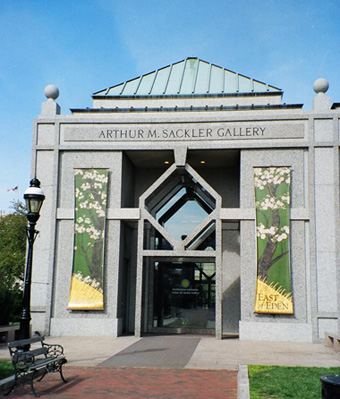 |
The exterior view of the Arthur M. Sackler Gallery (Photo by Lauren Marshall). |
They are among the thousands of exquisite pieces of Asian artwork found in the collections of the Freer Gallery of Art and the neighboring Arthur M. Sackler Gallery, located in the heart of the Mall.
Together, these two world-class galleries unite to form the national museum of Asian art for the United States.
The Freer and Sackler galleries are connected by an underground exhibition space, making it easy to be transported to China, Japan, India, Korea, Turkey and the rest of Asia all in one day.
Sidelle Wertheimer is a docent at the Freer and described to visitors what the founder, Charles Lang Freer, had intended when the gallery first opened in 1923.
“He felt that America should have an Asian presence on the Mall,” Wertheimer said.
She explained why Freer donated his vast collection of Asian art, saying that “he believed that if it was beautiful in one generation, it would be beautiful in another.”
The Sackler opened in 1987 to share the historical focus of its sister museum, the Freer.
As a docent at the Sackler, Robert Boies described to visitors one of the unique characteristics of the gallery, explaining that it is “the first major museum where the gallery is pretty much all below ground.”
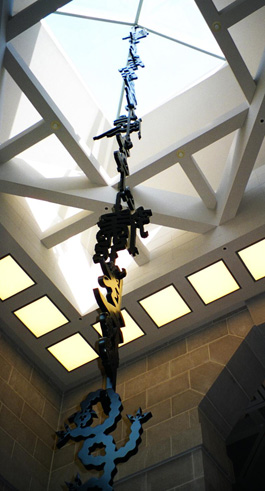 |
Xu Bing’s “Monkey’s Grasping for the Moon” suspended sculpture can be seen while walking down the stairwell in the Sackler (Photo by Lauren Marshall). |
While visitors walk down the stairwell in the Sackler, they can view the contemporary sculpture, “Monkeys Grasping for the Moon,” suspended from high atop the sky-lit atrium down through the gallery’s stairwell all the way down to the third-level reflecting pool.
Designed by expatriate Chinese artist Xu Bing, the sculpture of 21 interlocking “monkeys” was designed specifically for the Sackler.
“It was designed by a contemporary Chinese artist and deals with Buddhist legend,” Boies said. “The monkeys are hanging by their tails reaching down to see the moon in the water, reaching for the unattainable philosophically. Each one means ‘monkey’ in a different language.”
In “The Arts of China” collection on display at the Sackler, intricately carved ancient bronzes can be seen up close and personal by visitors.
“Some of the oldest pieces in the Sackler are the ancient bronze pieces, dating back to 1500 B.C.,” Boies said. “They were used in religious ceremonies and sacrificial ceremonies.”
Boies called attention to the Chinese ancient bronzes, explaining that “the detail seen on these pieces you don’t find on Mediterranean bronzes. I am constantly amazed at the perfection of the technique.”
Also, throughout “The Arts of China” collection, visitors can learn about the history of China and, by extension, its artwork by reading the several descriptions throughout the exhibit about each Chinese dynasty.
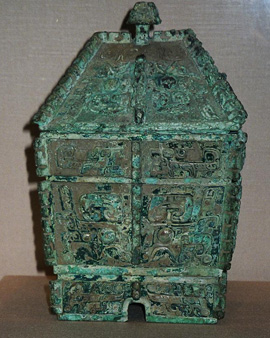 |
This “Ritual Food Container,” by Fang Yi, is one of many ancient Chinese bronzes located in the Sackler (Photo by Lauren Marshall). |
Working as a security guard at the Sackler for the past nine months, Arthur Stribling describes his work at the gallery as extremely exciting because “you get to meet people from all over the world and interact with them and see them learn.”
“Everything here is fascinating,” Stribling explained. “I learn something different from each collection and it challenges me to learn more.”
In addition to the regular collections, the Sackler, as well as the Freer, offers a variety of programs, exhibitions and tours in conjunction with the 2007 National Cherry Blossom Festival.
One such exhibit at the Sackler is the “East of Eden: Gardens in Asian Art” exhibition, which displays approximately 65 scrolls, paintings, textiles, ceramics and numerous other objects that highlight the rich visual tradition of gardens in Asian art.
Amanda Williams works in the Office of Public Affairs and Marketing for both the Freer and the Sackler galleries.
She explained visitors’ overall reactions to the “East of Eden” exhibit, saying that “many have said that it is the perfect entrée into spring and an added complement to the festivities of the Cherry Blossom Festival.”
Dolores Parsil is one such visitor, coming to the Sackler on her trip to Washington, D.C., from Virginia with her daughter, Kate Manzanares.
|
The sculpture of “Queen Sembiyan Mahadevi as Goddess Parvati” was made during the Chola period in India and can be found in the Freer (Photo by Lauren Marshall). |
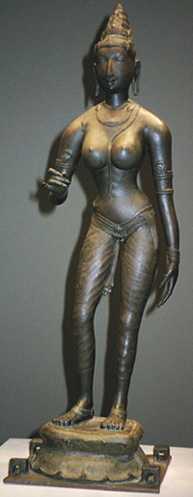 |
“I wouldn’t normally be attracted to Asian art, but because of the cherry blossoms, I came thinking it would broaden my horizons,” Parsil said.
Parsil and Manzanares attended one of the Sackler daily tours led by Boies, and enjoyed the educational experience.
“The tour guides are very informative and fun,” Manzanares said. “They provide great stories about the artwork.”
Other highlights of the Sackler collection include: ancient Near Eastern ceramics and metal wares; sculpture from South and Southeast Asia; Indian, Chinese, Japanese, Korean and South Asian painting; and 19th and 20th century Japanese prints and contemporary porcelain.
On the opposite end of the underground tunnel at the Freer, visitors can once again experience artwork from all across Asia, each piece being unique and with its own story to convey.
Wertheimer described the diversity of the artwork on view at the Freer.
“Each piece of art has different things to look at and different things to interpret,” Wertheimer said.
Other Cherry Blossom Festival events are take place at the Freer as well, including an ongoing exhibition of Japanese screens that range in date from the 15th to the 19th century. This exhibit of approximately 200 screens comprises one of the most important collections of its type in the world.
Another festival event at the Freer is the “Tea Bowls in Bloom, Botanical Decoration on Tea Ceremony Ceramics” exhibition, in which visitors can view delicately painted Japanese tea bowls and water jars that would have been used in traditional Japanese tea ceremonies.
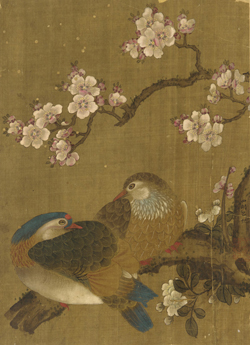 |
“Birds and Plum-Blossoms” is a painting that is possibly from Ming dynasty China (Image courtesy of the Freer Gallery of Art). |
A third related event at the Freer is the “Landscapes in Japanese Art” exhibition, which includes 12 ceramics and 20 paintings from the15th to the 19th centuries that illustrate landscapes by Japanese artists.
Wertheimer described the technique used by both Chinese and Japanese artists for this type of landscape artwork.
“Chinese and Japanese paintings have alike perspectives in that, depending on how you see the painting, the images are noticeable and have depth,” Wertheimer said. “If you look at more Western paintings, some images fade into the background depending on the view it is looked at, such as in the distance. That doesn’t happen in Chinese and Japanese paintings. Each view brings images to the forefront. That is a very magical thing.”
The ceramic dishes in the “Landscapes in Japanese Art” exhibit are particularly unique, according to Wertheimer.
“They [the Japanese artists] are showing you landscape even on their dishes,” Wertheimer enthusiastically explained.
“These types of dishes were meant to be used,” she said. “They are magnificent. I’ve never seen anything like them outside of the museum.”
| Two golden peacocks were painted by James McNeill Whistler on the wall of “The Peacock Room,” located in the Freer (Photo by Lauren Marshall). | 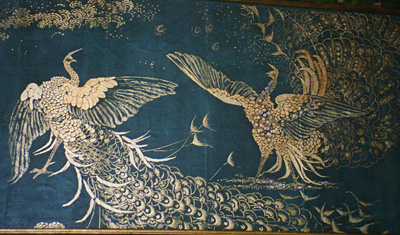 |
Although the Freer contains mostly Asian art, American art is also on display, including the world’s largest number of works by James McNeill Whistler.
While it might seem illogical to have a collection of American works in a gallery of mainly Asian art, Whistler’s work was strongly influenced by Chinese ceramics and Japanese prints.
Whistler’s inclusion at the gallery is even still appropriate when the fact that Freer became interested in Asian art as a direct result of his friendship with Whistler is taken into account.
One of the most famous objects in the Freer is “The Peacock Room” by Whistler. “The Peacock Room” was at one time the dining room in the London home of Frederick R. Leyland, a wealthy ship owner.
Whistler was commissioned to paint the room, which was ultimately purchased by Freer and installed in the gallery, and decorated it with bright golden peacocks and rich blue walls and ceilings.
Additional highlights of the Freer collection include art from China, Korea, India, Pakistan, Turkey, Iran, Iraq and Syria.
From art historians to art novices alike, all can be transported to Asia with a trip to the Freer and Sackler galleries in an experience that, according to Stribling, truly “enhances your view of different cultures.”
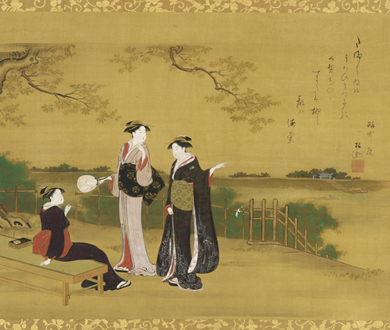 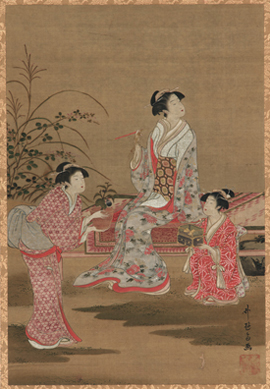 |
Top left, “Landscape: Three Young Women at the Matsuchiyama” is a hanging scroll attributed to Japanese artist Torii Kiyonaga. Bottom left, This hanging scroll is entitled, “Young Woman, with Two Girl Attendants, Seated in a Garden,” and is from the Edo period in Japan (Images courtesy of the Freer Gallery of Art). |
If You Go
The Freer Gallery of Art is located on Jefferson Drive at 12th Street S.W., on the National Mall.
The Arthur M. Sackler Gallery is located at 1050 Independence Ave., S.W., on the National Mall.
Both galleries are open every day except Dec. 25. Hours are from 10 a.m. to 5:30 p.m., and admission is free.
For more information, call: 202-633-4880 (Telephone; Mondays to Fridays, 8:30 a.m. to 5 p.m.), 202-633-0519 (24-hour recording) or 202-786-2374 (TTY)
| This “Cizhou or Cizhou-type ware wine jar” was made between the 13th century and the 15th century in China (Image courtesy of the Freer Gallery of Art). | 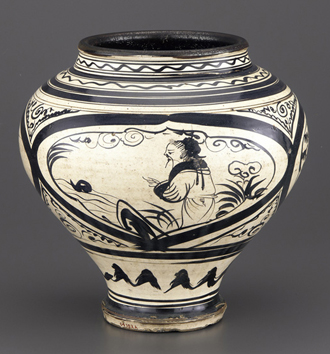 |
The handicap accessible entrance to the Freer Gallery is located on Independence Avenue at 12th Street, SW.
There is limited on-street parking available, including reserved spaces for visitors with disabilities.
The Freer and Sackler galleries do not have on-site food service. However, there are places to eat close by and in other Smithsonian museums. For more information, visit http://www.si.edu/dining/default.htm.
To learn more about the Freer and Sackler galleries, visit their Web site at http://www.asia.si.edu.
For information about tours, talks and other events at both galleries, visit http://www.asia.si.edu/events/index.asp. To learn more about the collections of both the Freer and Sackler, visit http://www.asia.si.edu/collections/default.htm. For a complete list of exhibitions at the Freer and Sackler, including the dates of the exhibit where applicable, visit http://www.asia.si.edu/exhibitions/default.htm. For information about visiting the Freer and Sackler galleries, go to http://www.asia.si.edu/visitor/default.htm.
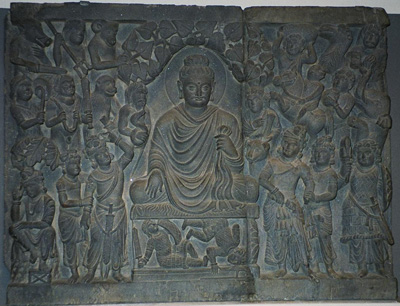 |
“The Enlightenment” is one in a series of Gandharan friezes from India illustrating the life of the Buddha that can be found in the Freer (Photo by Lauren Marshall). |

Comments are Closed